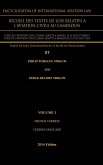- Gebundenes Buch
- Merkliste
- Auf die Merkliste
- Bewerten Bewerten
- Teilen
- Produkt teilen
- Produkterinnerung
- Produkterinnerung
The book provides readers with fundamental principles on how to think more critically about onboard security threats. Coverage offers methodological and tactically proven strategies for stopping violent acts onboard an aircraft inflight, teaching the reader how to counter inflight aggression and maintain tactical control of the cabin.
Andere Kunden interessierten sich auch für
![Countering Air Terrorism Countering Air Terrorism]() Pavel Pavlovich HachikyanCountering Air Terrorism105,99 €
Pavel Pavlovich HachikyanCountering Air Terrorism105,99 €![Air Traffic Control And Management Air Traffic Control And Management]() William BrownAir Traffic Control And Management47,99 €
William BrownAir Traffic Control And Management47,99 €![Countering Air Terrorism Countering Air Terrorism]() Pavel Pavlovich HachikyanCountering Air Terrorism76,99 €
Pavel Pavlovich HachikyanCountering Air Terrorism76,99 €![Life at 36,000 Feet Life at 36,000 Feet]() Sharon Carroll WilliamsLife at 36,000 Feet14,99 €
Sharon Carroll WilliamsLife at 36,000 Feet14,99 €![Drone Law and Policy Drone Law and Policy]() Drone Law and Policy169,99 €
Drone Law and Policy169,99 €![Fundamentals of International Aviation Law and Policy Fundamentals of International Aviation Law and Policy]() Benjamyn I. ScottFundamentals of International Aviation Law and Policy160,99 €
Benjamyn I. ScottFundamentals of International Aviation Law and Policy160,99 €![Encyclopaedia of International Aviation Law Encyclopaedia of International Aviation Law]() Philip Forsang NdikumEncyclopaedia of International Aviation Law53,99 €
Philip Forsang NdikumEncyclopaedia of International Aviation Law53,99 €-
-
-
The book provides readers with fundamental principles on how to think more critically about onboard security threats. Coverage offers methodological and tactically proven strategies for stopping violent acts onboard an aircraft inflight, teaching the reader how to counter inflight aggression and maintain tactical control of the cabin.
Produktdetails
- Produktdetails
- Verlag: CRC Press
- Seitenzahl: 282
- Erscheinungstermin: 7. April 2023
- Englisch
- Abmessung: 240mm x 161mm x 20mm
- Gewicht: 590g
- ISBN-13: 9781032373157
- ISBN-10: 1032373156
- Artikelnr.: 67258204
- Herstellerkennzeichnung
- Libri GmbH
- Europaallee 1
- 36244 Bad Hersfeld
- gpsr@libri.de
- Verlag: CRC Press
- Seitenzahl: 282
- Erscheinungstermin: 7. April 2023
- Englisch
- Abmessung: 240mm x 161mm x 20mm
- Gewicht: 590g
- ISBN-13: 9781032373157
- ISBN-10: 1032373156
- Artikelnr.: 67258204
- Herstellerkennzeichnung
- Libri GmbH
- Europaallee 1
- 36244 Bad Hersfeld
- gpsr@libri.de
Clay W. Biles is a former US Federal Air Marshal and inflight security instructor. Biles joined the Federal Air Marshal Service in 2008 and flew more than 1 million miles on international and domestic flights. Biles resigned in 2013 and founded High Order Security, a company that assists at-risk personnel in Latin America. He lives in the San Francisco Bay Area with his wife and two children.
I. The Basics of Inflight Security 1. Introduction to Inflight Security 2.
A Brief History of Threats to Civil Aviation 3.Terrorist Attack Planning
and Hijack Tactics 4. Inflight Jurisdiction, Inflight Awareness, and Layers
of Aviation Security II. Behavioral Detection and Adversary Recognition 5.
Passenger Profiles 6. Proactive Profiling 7. Surveillance Detection III.
Safety and Security Considerations 8. Flight Deck Door Procedure Awareness
9. Passenger Search and Restraint 10. Inflight Medical Response 11.
Inflight Fire Response IV. Tenets of Inflight Security 12. The Principles
of Inflight Security 13. The Tactical Mission Statement 14. Act Decisively
15. Use Speed, Surprise, and Aggression 16. Simplicity of Tactics 17.
Techniques Versus Principles 18. Communication 19. Six-Check 20. Aggressive
Mindset, Stress, and Motor Skills Management V. Counter-Hijack Response
Strategies 21. OODA-Loop Theory 22. Positions of Dominance and Advantage
23. Considerations for Armed First Responders 24. Considerations for
Unarmed First Responders 25. Least-Risk Bomb Location 26. Suicide-Bomber
Response 27. Aircraft-Specific Tactics for Armed First Responders 28.
Multi-Level Aircraft Considerations 29. Emergency Evacuation 30. Outside
Breach of Aircraft 31. Post-Incident Stabilization Conclusion
A Brief History of Threats to Civil Aviation 3.Terrorist Attack Planning
and Hijack Tactics 4. Inflight Jurisdiction, Inflight Awareness, and Layers
of Aviation Security II. Behavioral Detection and Adversary Recognition 5.
Passenger Profiles 6. Proactive Profiling 7. Surveillance Detection III.
Safety and Security Considerations 8. Flight Deck Door Procedure Awareness
9. Passenger Search and Restraint 10. Inflight Medical Response 11.
Inflight Fire Response IV. Tenets of Inflight Security 12. The Principles
of Inflight Security 13. The Tactical Mission Statement 14. Act Decisively
15. Use Speed, Surprise, and Aggression 16. Simplicity of Tactics 17.
Techniques Versus Principles 18. Communication 19. Six-Check 20. Aggressive
Mindset, Stress, and Motor Skills Management V. Counter-Hijack Response
Strategies 21. OODA-Loop Theory 22. Positions of Dominance and Advantage
23. Considerations for Armed First Responders 24. Considerations for
Unarmed First Responders 25. Least-Risk Bomb Location 26. Suicide-Bomber
Response 27. Aircraft-Specific Tactics for Armed First Responders 28.
Multi-Level Aircraft Considerations 29. Emergency Evacuation 30. Outside
Breach of Aircraft 31. Post-Incident Stabilization Conclusion
I. The Basics of Inflight Security 1. Introduction to Inflight Security 2. A Brief History of Threats to Civil Aviation 3.Terrorist Attack Planning and Hijack Tactics 4. Inflight Jurisdiction, Inflight Awareness, and Layers of Aviation Security II. Behavioral Detection and Adversary Recognition 5. Passenger Profiles 6. Proactive Profiling 7. Surveillance Detection III. Safety and Security Considerations 8. Flight Deck Door Procedure Awareness 9. Passenger Search and Restraint 10. Inflight Medical Response 11. Inflight Fire Response IV. Tenets of Inflight Security 12. The Principles of Inflight Security 13. The Tactical Mission Statement 14. Act Decisively 15. Use Speed, Surprise, and Aggression 16. Simplicity of Tactics 17. Techniques Versus Principles 18. Communication 19. Six-Check 20. Aggressive Mindset, Stress, and Motor Skills Management V. Counter-Hijack Response Strategies 21. OODA-Loop Theory 22. Positions of Dominance and Advantage 23. Considerations for Armed First Responders 24. Considerations for Unarmed First Responders 25. Least-Risk Bomb Location 26. Suicide-Bomber Response 27. Aircraft-Specific Tactics for Armed First Responders 28. Multi-Level Aircraft Considerations 29. Emergency Evacuation 30. Outside Breach of Aircraft 31. Post-Incident Stabilization Conclusion
I. The Basics of Inflight Security 1. Introduction to Inflight Security 2.
A Brief History of Threats to Civil Aviation 3.Terrorist Attack Planning
and Hijack Tactics 4. Inflight Jurisdiction, Inflight Awareness, and Layers
of Aviation Security II. Behavioral Detection and Adversary Recognition 5.
Passenger Profiles 6. Proactive Profiling 7. Surveillance Detection III.
Safety and Security Considerations 8. Flight Deck Door Procedure Awareness
9. Passenger Search and Restraint 10. Inflight Medical Response 11.
Inflight Fire Response IV. Tenets of Inflight Security 12. The Principles
of Inflight Security 13. The Tactical Mission Statement 14. Act Decisively
15. Use Speed, Surprise, and Aggression 16. Simplicity of Tactics 17.
Techniques Versus Principles 18. Communication 19. Six-Check 20. Aggressive
Mindset, Stress, and Motor Skills Management V. Counter-Hijack Response
Strategies 21. OODA-Loop Theory 22. Positions of Dominance and Advantage
23. Considerations for Armed First Responders 24. Considerations for
Unarmed First Responders 25. Least-Risk Bomb Location 26. Suicide-Bomber
Response 27. Aircraft-Specific Tactics for Armed First Responders 28.
Multi-Level Aircraft Considerations 29. Emergency Evacuation 30. Outside
Breach of Aircraft 31. Post-Incident Stabilization Conclusion
A Brief History of Threats to Civil Aviation 3.Terrorist Attack Planning
and Hijack Tactics 4. Inflight Jurisdiction, Inflight Awareness, and Layers
of Aviation Security II. Behavioral Detection and Adversary Recognition 5.
Passenger Profiles 6. Proactive Profiling 7. Surveillance Detection III.
Safety and Security Considerations 8. Flight Deck Door Procedure Awareness
9. Passenger Search and Restraint 10. Inflight Medical Response 11.
Inflight Fire Response IV. Tenets of Inflight Security 12. The Principles
of Inflight Security 13. The Tactical Mission Statement 14. Act Decisively
15. Use Speed, Surprise, and Aggression 16. Simplicity of Tactics 17.
Techniques Versus Principles 18. Communication 19. Six-Check 20. Aggressive
Mindset, Stress, and Motor Skills Management V. Counter-Hijack Response
Strategies 21. OODA-Loop Theory 22. Positions of Dominance and Advantage
23. Considerations for Armed First Responders 24. Considerations for
Unarmed First Responders 25. Least-Risk Bomb Location 26. Suicide-Bomber
Response 27. Aircraft-Specific Tactics for Armed First Responders 28.
Multi-Level Aircraft Considerations 29. Emergency Evacuation 30. Outside
Breach of Aircraft 31. Post-Incident Stabilization Conclusion
I. The Basics of Inflight Security 1. Introduction to Inflight Security 2. A Brief History of Threats to Civil Aviation 3.Terrorist Attack Planning and Hijack Tactics 4. Inflight Jurisdiction, Inflight Awareness, and Layers of Aviation Security II. Behavioral Detection and Adversary Recognition 5. Passenger Profiles 6. Proactive Profiling 7. Surveillance Detection III. Safety and Security Considerations 8. Flight Deck Door Procedure Awareness 9. Passenger Search and Restraint 10. Inflight Medical Response 11. Inflight Fire Response IV. Tenets of Inflight Security 12. The Principles of Inflight Security 13. The Tactical Mission Statement 14. Act Decisively 15. Use Speed, Surprise, and Aggression 16. Simplicity of Tactics 17. Techniques Versus Principles 18. Communication 19. Six-Check 20. Aggressive Mindset, Stress, and Motor Skills Management V. Counter-Hijack Response Strategies 21. OODA-Loop Theory 22. Positions of Dominance and Advantage 23. Considerations for Armed First Responders 24. Considerations for Unarmed First Responders 25. Least-Risk Bomb Location 26. Suicide-Bomber Response 27. Aircraft-Specific Tactics for Armed First Responders 28. Multi-Level Aircraft Considerations 29. Emergency Evacuation 30. Outside Breach of Aircraft 31. Post-Incident Stabilization Conclusion









